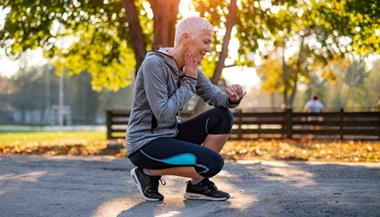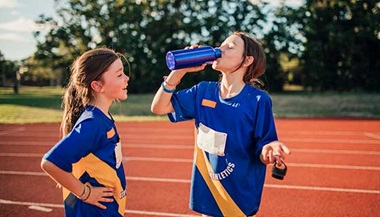Heat-Related Illnesses (Heat Cramps, Heat Exhaustion, Heat Stroke)
What are heat-related illnesses?
Exposure to abnormal or prolonged amounts of heat and humidity without relief or adequate fluid intake can cause various types of heat-related illness. Children and teens adjust more slowly than adults do to changes in environmental heat. They also produce more heat with activity than adults, and sweat less. Sweating is one of the body's normal cooling mechanisms. Children and teens often do not think to rest when having fun and may not drink enough fluids when playing, exercising, or participating in sports.
Children and teens with chronic health problems, or those who take certain medicines, may be more susceptible to heat-related illnesses. Children and teens who are overweight or wear heavy clothing during exertion, such as marching band or football uniforms, are also more susceptible.
There are 3 types of heat-related illnesses:
-
Heat cramps
-
Heat exhaustion
-
Heat stroke
What are heat cramps?
Heat cramps are the mildest form of heat illness and consist of painful muscle cramps and spasms that occur during or after intense exercise and sweating in high heat.
What is heat exhaustion?
Heat exhaustion is more severe than heat cramps and results from a loss of water and salt in the body. It occurs in conditions of extreme heat and excessive sweating without adequate fluid and salt replacement. Heat exhaustion occurs when the body is unable to cool itself properly and, if left untreated, can progress to heat stroke.
What is heat stroke?
Heat stroke, the most severe form of heat illness, occurs when the body's heat-regulating system is overwhelmed by excessive heat. It is a life-threatening emergency and requires immediate medical attention.
Symptoms and first-aid measures for heat injuries
The following chart contains the most common symptoms of heat-related illness. Specific treatment will be determined by your child's doctor and may include some, or more, of the following:
| Condition | Symptoms | First-aid and treatment |
|---|---|---|
| Heat cramps |
|
|
| Heat exhaustion |
|
|
| Heat stroke |
|
|
How can heat stroke be prevented?
Some general guidelines to help protect your child from heat-related illnesses include the following:
-
Drink plenty of fluids during vigorous or outdoor activities (including sunbathing), especially on hot days. Drinks of choice include water and sports drinks; avoid alcohol and fluids with caffeine, such as tea, coffee, and cola, as these can lead to dehydration.
-
Make sure your child dresses in light colored, lightweight, tightly-woven, loose-fitting clothing on hot days.
-
Schedule vigorous activity and sports for cooler times of the day. Take rest periods in shady or cool areas.
-
Makes sure your child is protected from the sun and wears a hat and sunglasses, and uses an umbrella. Use a sunscreen that is at least SPF (sun protection factor) 15.
-
Increase time spent outdoors gradually to get your child's body used to the heat.
-
Teach children to take frequent drink breaks and "wet down" or mist themselves with a spray bottle to avoid becoming overheated.
-
Try to spend as much time indoors as possible on very hot and humid days.
-
Teach your child to warm-up and cool-down before and after exercising.
-
If your child has a medical condition or is taking medicine, consult his or her doctor for further advice for preventing heat-related illnesses.





